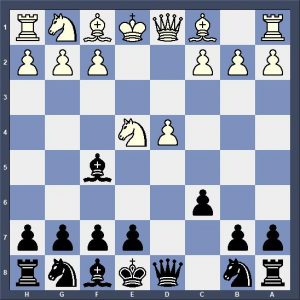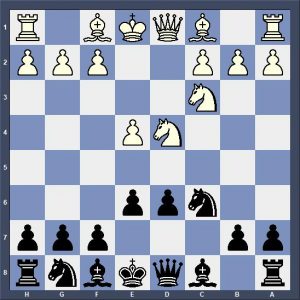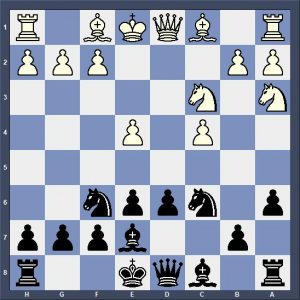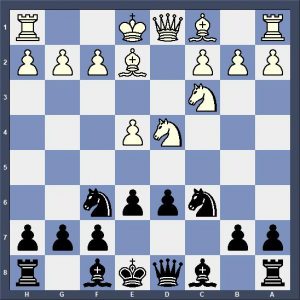There are 50 ways to leave your lover and 50 ways to die in the west and maybe not 50, but quite many different ways to win a Deep Sicilian. As mentioned in the previous post, learning an opening translates to knowing the most important pawn structures, the typical strategic and tactical patterns and some concrete bits of theory. All of this should result in understanding the big picture logic of that opening. You ought to be acquainted with the prevalent strategic themes and have a good notion of how games are typically won or lost with your variations. The losing patterns are important, so you know the risks and the positions you better avoid. The winning ideas are even more important, as they provide you with the variety of plans you may choose from. Ideally, you start learning an opening by playing through a decent amount of victorious games by grandmasters who carry the flag of your lines. After that you will have an idea, whether you really like what you see and whether it is worth to work your way through a big tome from cover to cover. Thematic games with a positive outcome are also a fantastic motivation and will drive you to put in the necessary amount of hours.
Number of winning ideas = positional depth
The richness and strategical depth of an opening can be determined by the variety of winning schemes. If you have a look at the Caro-Kann main line after 1.e4 c6 3.d4 d5 3.Nd2 exd5 4.Nxe4 Bf5, you will find a couple of different winning patterns, but not too many.

The structure is relatively simple and there are only a few sub-structures. The line also doesn’t make full use of other dimensions of chess. For instance, topics such as attacking or positional sacrifices are only represented by a small extend in Black’s setups. That said, I hold the Caro-Kann in high regard for what it is, namely a solid and robust opening, which yields good chances of equalizing for Black. In that capacity, it is used by players of all levels, including top grandmasters, who have a conservative approach or are content with a draw in a specific game.
Ambitions
Of course, the winning potential is closely linked to the amount of winning ideas and these are a function of positional depth, active dimensions and the resulting number of potential imbalances. In that respect, the Deep Sicilians shine and outperform all other openings. With no other tools you will have such a big chance to beat inferior competition or opponents of equal strength with the black pieces. I know, there are different philosophies. The classical Russian school of chess displayed a preference for a solid approach with the black pieces and more ambitious actions with White. Among the top players, Kramnik, for instance, represents such a temperament. In my opinion, this strategy requires certain skills. You have to ask yourself: “Am I good enough to get my draw with Black in the wide majority of games and is my service with White hard enough to extract a big amount of full points with it? But even many top players, who definitively have these skills, are not content with the prospect of playing for a draw with Black. Normally, this somewhat lazy mindset doesn’t catapult a player above 2700 Elo, neither will it allow a 2600-player to make a good living by regularly finishing in the top 5 of strong open tournaments. What suits the requirements of a top player can also be applied to the amateur. Who doesn’t want to win the second group of his club championships and qualify to play in the primer group the coming year? Who doesn’t want to play in the first team? If you have high ambitions, you might want to rethink your playing style with Black.
My connection with the Deep Sicilians
I played four Deep Sicilian openings in my life. The Scheveningen, the Najdorf, the Kan and the Four Knights. The Scheveningen I tried to reach via the move order 1.e4 c5 2.Nf3 e6 3.d4 cxd4 4.Nxd4 Nc6 5.Nc3 d6.

This for two reasons. First of all, I was looking for a way to avoid the strong Keres Attack (6.g4 after the normal Scheveningen move order). Secondly, I was quite keen on reaching a Hedgehog-structure after 5.Nb5 d6 6.c4 Nf6 7.N1c3 a6 8.Na3 Be7 etc.

It is difficult for Black to obtain a Hedgehog after 1.e4 (in contrast to 1.c4) and even harder to get a good version of it. This Paulsen-type is quite nice for Black, as the knight is not ideally placed on a3. I started to play the Hedgehog in 1984 and I am still in love. Between 2003 and 2005 I published a series about the Hedgehog in the German magazine SCHACH and managed to win many readers over into the camp of the Hedgehog aficionados. The problem with the Paulsen-move order is that many white players are not compliant by playing either 5.Nb5 (Hedgehog) or 5.Nc3 d6 6.Be2 (Scheveningen), but rather go for 6.f4 or 6.Be3 heading for dangerous systems, such as the English Attack (7.f3, 8.Qd2) or the Velimirovic Attack (7.Bc4, 8.Qe2).
The Najdorf I played when I was already grandmaster for a couple of years. As I recently rewatched the movie scene where Obi-Wan Kenobi referred to the laser sword as an elegant weapon, it reminded me of the Najdorf. Difficult, but highly effective. With White, I suffered from poor results against it. Unfortunately, I had to abandon it, when I seized a business opportunity in 1998 and ended my career as a playing professional. It simply was too high maintenance.
I then switched to the Kan, which I still like quite a lot. If I were to play professional chess today, I would probably alternate between the Kan and the Four Knights. With the Kan you have the highest “Hedgehog-probability” after 1.e4. It can also lead to sharp play, but leaves more room for improvisation compared to the Najdorf.
The Four Knights and the Deep Sicilian centre
My story with the Four Knights is already told in other parts of this website. But let me refresh the Deep Sicilian aspect. One of the advantages of the Four Knights is its flexibility regarding the central structure. In most cases (against most White’s options on move 6) Black can choose between setting up a Deep Sicilian centre or going for active piece play by means of Bb4 or Bc5, often in combination with the pawn thrust d7-d5. Flexibility is a fantastic thing in itself, as it serves both purposes: making life more difficult for the white player, as he has to be prepared for different branches (in practice the preparation against the Four Knights is not that great sub 2300, as it still operates pretty much under the radar), and further, providing Black with the opportunity to cherry-pick. He can make his choice dependent of what objectively fares better against a specific white move or he can use his own style or his own skills as determinants. Generally, the Deep Sicilian centre is rather difficult, so I would tend to opt for active piece play under ELO 1900-2000 or with a lack of experience in the Sicilian.
However, I think against 6.Be2, opting for the Deep Sicilian by playing 6..d6 is the right choice for objective reasons.

This claim will be backed in an extra post, sometime in the near future. Very conveniently, you can also kill the popular line 6.a3 with the same strategy, which is already one of the reasons. Yes, a nice side-aspect of my repertoire is that you learn how to play the Classical Scheveningen en passant. Of course, the presented lines are robust and easy to handle. No one will get mated in the course of a systematic attack, as I will still demonstrate.
And for the Hedgehog fans the good news is, that equipped with the Four Knights, you can now venture 1.e4 c5 2.Nf3 e6 3.d4 cxd4 4.Nxd4 Nc6, as I did in the eighties. After 5.Nc3 you don’t have to play 5..d6 and suffer from the English Attack. You simply play 5..Nf6 and enjoy your Four Knights.
